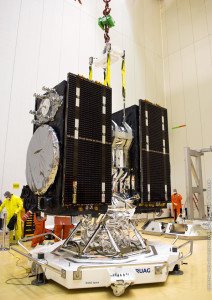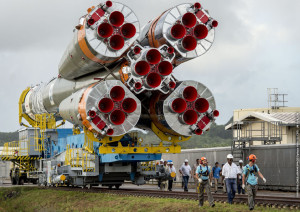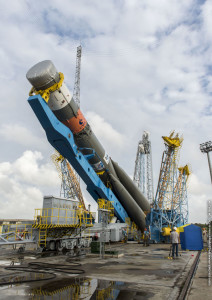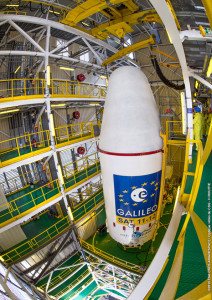This is a summary of the main milestones achieved in Kourou in the last days, before declaring the green light in the Launch Readiness Review.
December 10
Installation of Galileo 11 and 12 and their dispenser system atop Soyuz Fregat occurred in the European Spaceport’s S3B clean room facility. The dispenser will deploy the satellites by firing a pyrotechnic system for separation in opposite directions at the orbital insertion point.
Fregat operates as Soyuz’ fourth stage, providing an autonomous and flexible propulsion system. Built by Russia’s NPO Lavochkin, it will perform two propulsion burns during the Galileo mission with the upper stage designed to be restarted up to 20 times in flight.
December 14
Rollout and vertical positioning of the Soyuz three-stage vehicle. Soyuz was moved via a transport/erector rail car in a horizontal-transfer process from the MIK launcher assembly facility to the Soyuz ELS launch complex. Once on the launch pad, Soyuz was erected to the vertical orientation, where it was suspended in place by four large support arms, followed by the transport/erector rail car’s withdrawal.
With this step complete, the mobile gantry was moved into position around the launcher, providing protection for the subsequent installation of Soyuz’ “upper composite”. The so called “upper composite” is composed of the two Galileo spacecraft and their dispenser system, the Fregat upper stage and payload fairing.
December 15
The Soyuz vehicle’s final integration process at the Spaceport. After “upper composite” transfer to the ELS launch zone, it was hoisted inside the mobile gantry, then integrated with Soyuz to complete the launcher’s build-up.
The December 17 Arianespace’s VS13 Soyuz mission, will be Soyuz’ 13th liftoff from the Spaceport since its introduction in 2011. With a total payload weight of 1,434 kg, it is scheduled to lift off, at precisely 8:51:56 a.m. local time in French Guiana, (12:51:56 CET, 11:51:56 UTC). Galileo 11 and 12 will be deployed after a flight lasting approximately 3 h. 47 min.
This is the sixth Galileo launch overall and the third launch of 2015, set to bring the number of satellites in space up to 12.
It takes place just 11 days before the 10th anniversary of the liftoff of Europe’s very first navigation satellite. The experimental GIOVE-A took off on 28 December 2005 to reserve operational frequencies, test key hardware and gather data on the orbital environment for the Galileo constellation to follow. GIOVE-B followed in April 2008.




